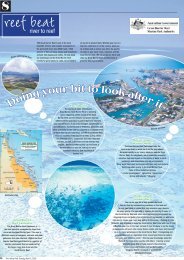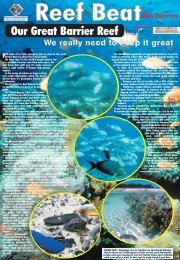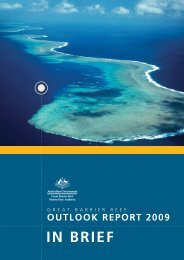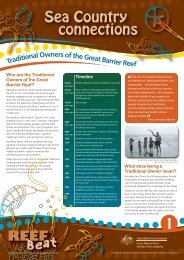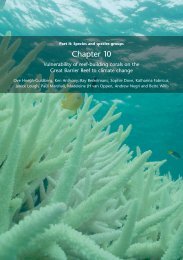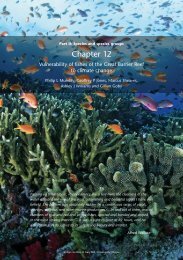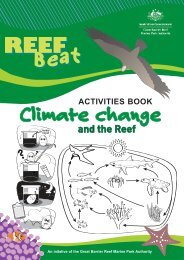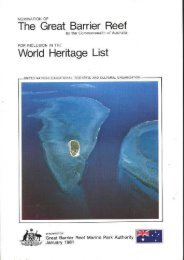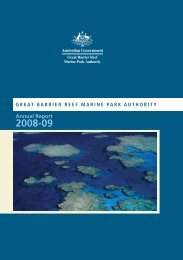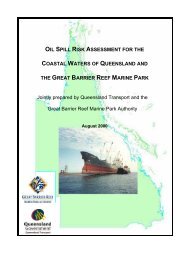Coral Bleaching Response Plan - Great Barrier Reef Marine Park ...
Coral Bleaching Response Plan - Great Barrier Reef Marine Park ...
Coral Bleaching Response Plan - Great Barrier Reef Marine Park ...
You also want an ePaper? Increase the reach of your titles
YUMPU automatically turns print PDFs into web optimized ePapers that Google loves.
<strong>Great</strong> <strong>Barrier</strong> <strong>Reef</strong> <strong>Coral</strong> <strong>Bleaching</strong> <strong>Response</strong> <strong>Plan</strong> 2005/2006<br />
If a bleaching event occurs, Quickbird (2.4m pixels) image data will be captured over the sites where<br />
bleaching surveys are conducted. These images will cover 10 km x 10 km sections and will be used to<br />
map bleached versus non-bleached coral areas.<br />
Objectives: Assess the spatial extent and distribution of coral bleaching for select locations along<br />
the GBR;<br />
Strategies: • Utilise satellite imagery (at a spatially relevant scale) to document coral cover<br />
and extent of bleaching at target reefs<br />
• Build hierarchical system using satellite imagery, and in-water data to get a<br />
complete picture and possibly predictive capacity for extent of bleaching<br />
3.2 <strong>Bleaching</strong> Surveys<br />
Although the phenomenon of bleaching has received much attention, the ecological significance of<br />
mass bleaching is still poorly understood. Severe bleaching events have the potential to kill large areas<br />
of living coral, and consequently cause major disturbance to coral reef ecosystems. However, the fate of<br />
bleached corals cannot readily be predicted from observations of the severity or extent of bleaching.<br />
Widespread bleaching does not necessarily equate to widespread coral mortality. To better understand<br />
the long-term implications of these events information on the extent and patterns of coral mortality that<br />
result from bleaching need to be measured.<br />
In-water bleaching surveys will provide more precise information about the percentage and types of<br />
corals that bleach, and then subsequently die or survive. Over longer time frames, the bleaching surveys<br />
will also enable the direction and rate of community recovery to be evaluated. The quantitative data<br />
provided by the bleaching surveys will enable the testing of hypotheses about differences or trends<br />
between sites or through time. Differences in coral community structure that may occur because of<br />
bleaching and mortality will be detected, and information on whether certain community types are more<br />
susceptible to bleaching than others can be obtained.<br />
<strong>Bleaching</strong> surveys will use a combination of rapid visual assessment and more detailed video transects<br />
to provide information about the bleaching event and its ecological impacts. The rapid assessment and<br />
video transects will be done simultaneously at all sites. The two techniques are designed to be<br />
complimentary: the rapid assessment provides basic information about the severity of the bleaching<br />
event in near real-time, while the video transects provide more detailed information, but require<br />
intensive analysis that normally takes weeks to months to complete. Details on site selection,<br />
integration with the AIMS LTMP and survey methods are outlined in the following section Survey<br />
Design and Methods.<br />
Objectives: Assess the percentage of coral bleaching, affected species and mortality for<br />
select reefs along the GBR<br />
Strategies: • Rapid visual assessments to document coral cover, community<br />
composition, and severity of bleaching at target reefs<br />
• Video transects to quantify coral cover, community composition,<br />
and extent and pattern of bleaching at target reefs<br />
• Ground truth aerial data using in-water fine scale surveys<br />
Climate Change <strong>Response</strong> Programme - GBRMPA 7



